Policy Reports 2022
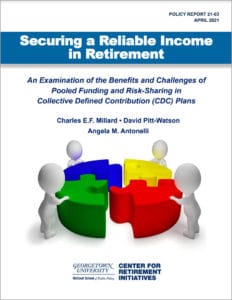
Policy Report 21-03 | April 2021
Securing a Reliable Income in Retirement: An Examination of the Benefits and Challenges of Pooled Funding and Risk-Sharing in Collective Defined Contribution (CDC) Plans
Private sector workers in the United States continue to struggle to find a cost-effective way of securing a reliable income in retirement. The US is not alone in facing this challenge. In both the Netherlands, and most recently now in the United Kingdom (UK), collective defined contribution (CDC) plans are being used to provide lifetime income. Recent studies of CDC plan experience in Europe suggest that a CDC plan can be simple and low-cost in design and generate a retirement income at least 30% higher than a typical DC plan. This paper reviews the benefits, risks, and challenges in CDC plans based on experiences in the Netherlands and the UK, and concludes with some lessons for US.
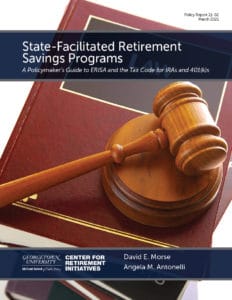
Policy Report 21-02 | March 2021
State-Facilitated Retirement Savings Programs: A Policymaker’s Guide to ERISA and the Tax Code for IRAs and 401(k)s
This paper provides policymakers with a primer about ERISA and the Tax Code, how these federal laws and their regulations pertain to IRAs and 401(k)s, and what this means for state-facilitated retirement savings programs. After reviewing the question of ERISA applicability to state auto-IRAs and an overview of the federal Tax Code and IRA rules, it explores how ERISA and the Tax Code rules apply to 401(k)s, including the new rules allowing states (and others) to possibly lower 401(k) costs by sponsoring group 401(k)MEPs and PEPs.
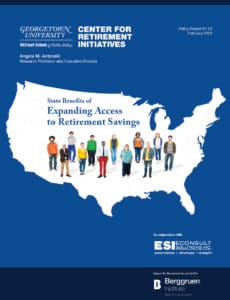
Policy Report 21-01 | February 2021
State Benefits of Expanding Access to Retirement Savings
This report provides state-level analysis of the benefits of expanding worker access to save for retirement through state-facilitated auto-IRA programs. This report follows CRI’s earlier research on the potential benefits of national universal access to retirement savings options for U.S. workers (See Policy Report 20-02). Included in the analysis are 51 state (and DC) fact sheets that provides information on key state specific metrics including demographic trends related to the aging of the population, the size of the retirement savings access gap, the projected growth in savings with an auto-IRA program, and the economic and fiscal benefits to the state of adding new savers. (See State-by-State Interactive Map)

Policy Report 20-02 | December 2020
What Are the Potential Benefits of Universal Access to Retirement Savings? An Analysis of National Options to Expand Coverage
This report analyzes the potential benefits of national universal access to retirement savings options for U.S. workers. It examines how characteristics such as account type (payroll deduction IRA vs. 401(k)), the employers required to participate, and default levels of employee contributions and any employer contributions will drive access, savings, asset growth, and retirement income over time. The economic and fiscal benefits of a national approach to the universal access is enormous, contributing to significant growth in GDP and reduced federal and state spending on benefit programs for the elderly. This report draws from the experience of other countries and from the early state-facilitated retirement programs in the U.S. to make the case that universal access to retirement savings options can be achieved in a simple, cost-effective manner with private market providers ready to compete to offer options for workers. (Infographic | Methodology Appendix)
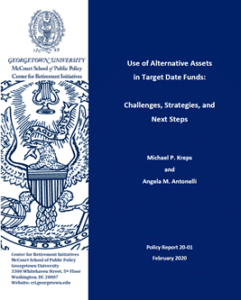
Policy Report 20-01 | February 2020
Use of Alternative Assets in Target Date Funds: Challenges, Strategies, and Next Steps
This report describes the potential benefits that allocation to alternative assets could offer a TDF’s investment portfolio, including enhanced retirement income for participants, with some case study considerations and international examples. It identifies and explains the unique challenges a fiduciary should consider when deciding to include alternatives in a TDF, as well as appropriate strategies a fiduciary may use to apply appropriate due diligence. Finally, to support and encourage this innovation, the report recommends action by DOL to clarify a fiduciary’s responsibility when including alternatives in TDFs.

Policy Report 19-02 | June 2019
Generating and Protecting Retirement Income in Defined Contribution Plans: An Analysis of How Different Solutions Address Participant Needs
This report analyzes how different lifetime income solutions can help retirees meet their lifetime income needs. It examines several options to determine how well they achieve different objectives for retirement income including stability, maximization, longevity protection, growth potential, asset preservation, cost and liquidity. It highlights the growing demand for lifetime income solutions and the need for policymakers and plan sponsors to begin to integrate these solutions into retirement plans as more plan participants come to expect their DC plans to help generate and protect income for retirement.
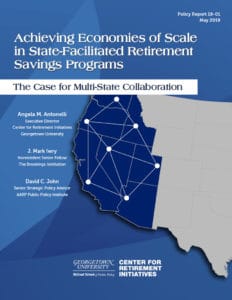
Policy Report 19-01 | May 2019
Achieving Economics of Scale in State-Facilitated Retirement Savings Programs: The Case for Multi-State Collaboration
This final report updates and replaces CRI Working Paper 18-02, published in June 2018. This report outlines several models, based on a multi-state or regional approach, that should be explored for how states can work together to serve more than one state. Although individual states can establish their own state-sponsored retirement savings programs, the consideration of interstate arrangements offers opportunities for states to explore how they can achieve economies of scale to help minimize costs while significantly expanding access to retirement savings options.
